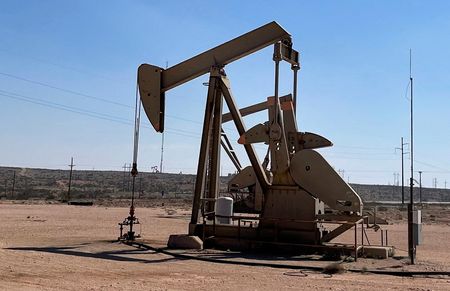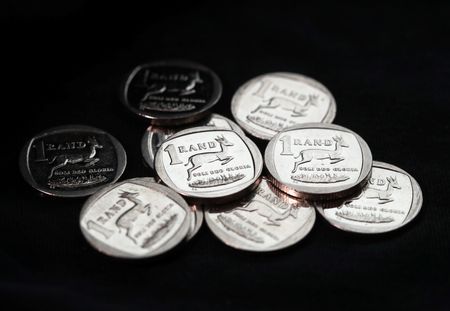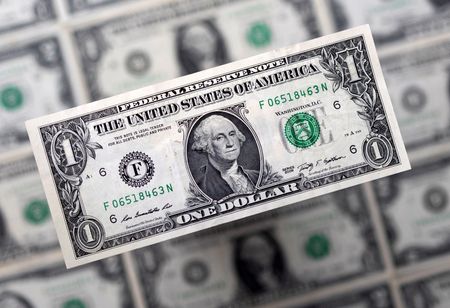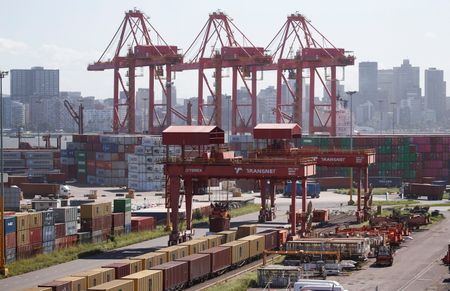By Georgina McCartney
LONDON (Reuters) -Oil prices fell on Thursday on expectations for a U.S.-Iran nuclear deal that could result in sanctions being eased and more barrels released onto the global market.
Brent crude futures were down $1.47, or 2.22%, to $64.62 a barrel at 12:53 p.m. EDT (1653 GMT). U.S. West Texas Intermediate crude futures were down $1.43, or 2.26%, at $61.72.
U.S. President Donald Trump said on Thursday that the U.S. was getting close to securing a nuclear deal with Iran, and Tehran had “sort of” agreed to the terms.
An Iranian official told NBC News in an interview published on Wednesday that Iran was willing to agree to a deal with the U.S. in exchange for lifting economic sanctions.
“(Any) immediate sanctions relief stemming from a nuclear agreement could unlock an additional 0.8 million barrels per day of Iranian crude for the global market – an undeniably bearish development for prices,” SEB analyst Ole Hvalbye said.
Washington issued sanctions on Wednesday to target Iranian efforts to domestically manufacture components for ballistic missiles, the U.S. Treasury Department said, following Tuesday’s sanctions on some 20 companies in a network that it said has long sent Iranian oil to China.
The sanctions followed a fourth round of U.S.-Iran talks in Oman aimed at addressing disputes over Iran’s nuclear programme.
“We are swinging between President Trump zeroing out Iran to bringing them into the community of nations, so the threat to supply is in both directions, with either some Iranian barrels continually snuck onto the market or we get the full benefit of Iranian production, that is what is swinging the price,” said John Kilduff, partner at Again Capital in New York.
Elsewhere, Russia’s Vladimir Putin spurned a challenge to meet face-to-face with Ukrainian President Volodymyr Zelenskiy in Turkey on Thursday, dealing a blow to prospects for a peace breakthrough.
Zelenskiy said Putin’s decision to send what he called a “decorative” lineup showed the Russian leader was not serious about ending the war.
“I think that is supportive because part of the bear case for prices is that if this Ukraine-Russia situation resolves itself then we can get that Russian supply onto the global market,” Kilduff said.
Meanwhile, the International Energy Agency lifted its oil demand growth forecast in 2025 to 740,000 barrels per day, up 20,000 bpd from the previous report, citing higher economic growth forecasts and lower oil prices supporting consumption.
The IEA said economic headwinds and record sales of electric vehicles are expected to reduce demand growth to 650,000 bpd for the remainder of the year, from growth of nearly 1 million bpd in the first quarter.
The Organization of the Petroleum Exporting Countries and allied producers, known as OPEC+, has been increasing supply, although OPEC on Wednesday trimmed its forecast for growth in oil supply from the U.S. and other producers outside the wider OPEC+ group this year.
Weighing on prices, data from the U.S. Energy Information Administration on Wednesday showed crude stockpiles rose by 3.5 million barrels to 441.8 million barrels last week, compared with analysts’ expectations in a Reuters poll for a 1.1 million-barrel draw. [EIA/S]
Black Sea CPC Blend crude oil exports are pencilled in at 1.6 million to 1.7 million bpd in June, several trading sources with knowledge of the month’s loadings told Reuters.
At that level, loadings will be higher than the approximately 1.5 million bpd scheduled for export in May.
(Additional reporting by Yuka Obayashi in Tokyo, Emily Chow in Singapore, Seher Dareen and Ahmad Ghaddar in London. Editing by Barbara Lewis, Kirsten Donovan and Rod Nickel)









